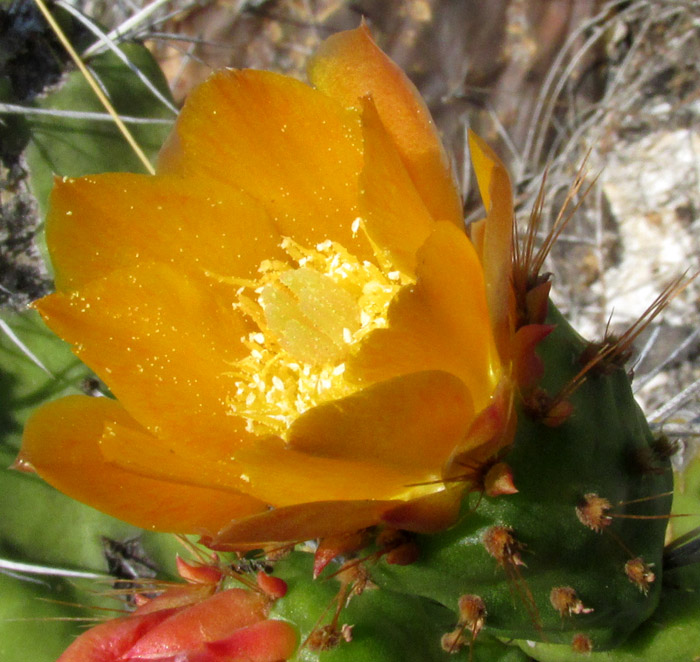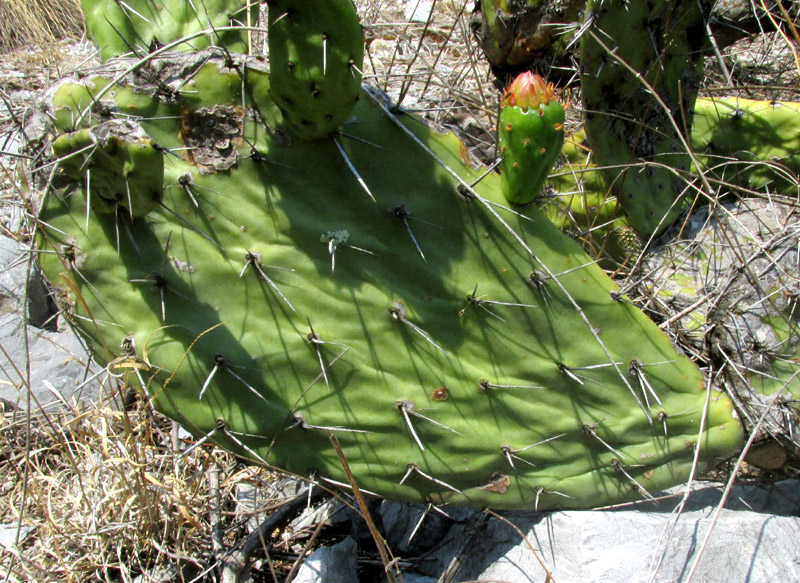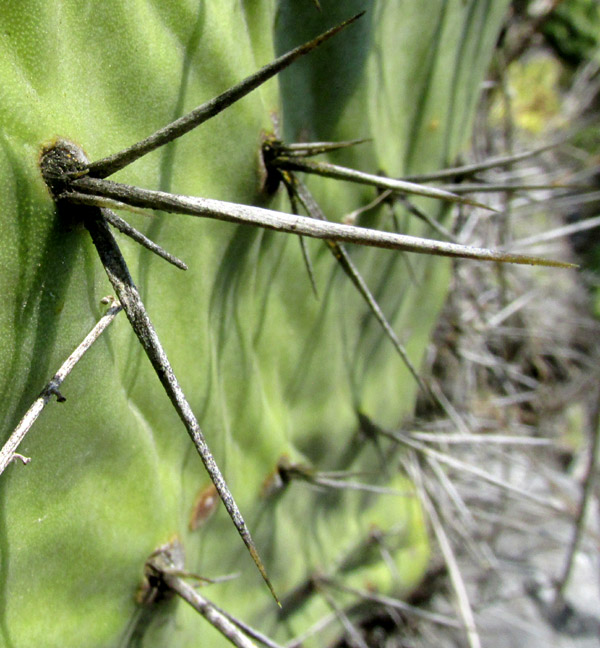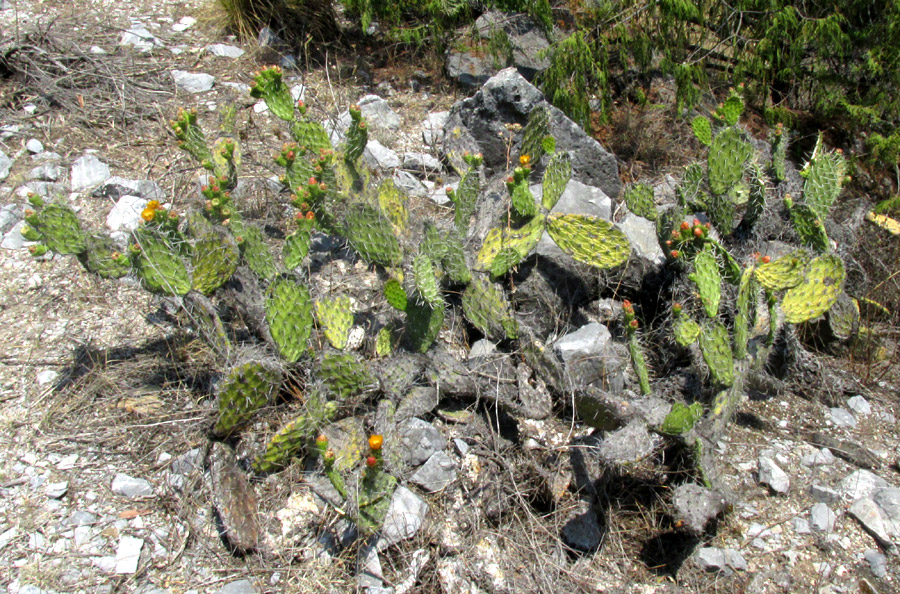Excerpts from Jim Conrad's
Naturalist Newsletter
entry from field notes dated May 4, 2023, taken about 150m upslope on NE-facing slope, above intersection of road from Hwy 120 to San Joaquín, with road to El Doctor; juniper and pine forest on limestone bedrock; elevation ±2425m (7950 ft); Eastern Sierra Madre mountains of east-central Querétaro state, MÉXICO, (N20.88°, W99.62°)
"RZEDOWSKI'S PRICKLYPEAR"

On steeply sloping talus below an old limestone quarry, a large, sprawling pricklypear cactus bore a few blossoms of which the petal-like tepals were the rich golden color shown above. We have plenty of yellow-flowered pricklypears, and yellow flowers tinged with pink, but this golden hue was something new to me.

Only about four flowers were open, but numerous flower buds were developing, their young tepals reddish, not golden. Later, during the identification process, I'd see the importance of noting that on unopened flower buds such as the one peeping in at the above picture's top, left corner, the tepals formed a sharp tip at the top, not a rounded top. Also the ovaries are somewhat thickened, not particularly narrow.

The cactus's stem segments were beavertail-shaped, or obovate, and wrinkled. We were at the end of an especially long, dry, dry season after a rainy season that hardly developed, so probably the wrinkles were just from drying out. Two or three white spines emerged from each areole, mostly directed downward.

The spines themselves were flattened on one side and tended to twist. Their tips were darkened and, within the spine group, each spine was of a different length. Above you can also see that no short, dense hairs formed a velvety covering on the pad surface. Nor were there dense collections of tiny spines called glochids at the spines' base, though areoles on ovaries had them. Our cactus pad was an old one, so maybe its glochids had worn off.

The cactus's many branches arose from no apparent trunk. Note how the cactus's lower stem segments are bleached of greenness. I'm guessing that this is an adaptation against intense sunlight reflecting off the white limestone rocks, or maybe it's a consequence of the historical drought the area has been enduring.
For this part of upland central Mexico, the taxonomy of the pricklypear genus Opuntia hasn't been worked out. Still, through a variety of sources it could be determined that our golden-flowered cactus was one of two species, both endemic just to Mexico: Opuntia lasiacantha and Opuntia rzedowskii. The interesting feature about that is indicated by the title of the 2021 study by César Ramiro Martínez-González and Jesús Morales-Sandoval entitled "Taxonomic status of two controversial species of Opuntia (Cactaceae) from Mexico based on morphological and molecular data."
"Two controversial species" ... Controversial because they're so similar that for a long time it's been suspected that two different names were being used for one variable species. However, Martínez-González and Morales-Sandoval convincingly demonstrate that two different species are to be recognized, and with the publication's pictures and notes it's clear that our talus species is the by far rarer and less known of the two, OPUNTIA RZEDOWSKII.
Besides its genes, observable features distinguishing Opuntia rzedowskii from Opuntia lasiacantha is the former's lack of an obvious trunk, its golden blossoms instead of yellow ones, the pointed tops of flower buds as opposed to rounded tops, and the ovaries not being particularly slender.
In English I call it "Rzedowski's Pricklypear," with quotation marks because I've seen no use of that English name elsewhere, though the binomial suggests it. In Spanish it's nopal de pedregal, something like "Rocky-place Pricklypear." The species is described as having a very limited distribution in the central Mexican highlands, restricted to dry, rocky and grassy environments. Opuntia rzedowskii wasn't formally recognized as a species until 1976. Its distribution and sparse occurrence is documented on its GBIF distribution map.
That name so hard for English speakers to deal with, Rzedowski, is worthy for honoring newly recognized Mexican plants, as it has been not only for our "Rzedowski's Pricklypear," but also for the "Rzedowski's Pine," "Rzedowski's Sycamore," "Rzedowski's Pachyphytum, or Moonstone," Rzedowski's Cycad," "Rzedowski's Deer-tongue Fern," "Rzedowski's Loeselia or False Calico," on and on... You can see all the taxa named in Jerzy Rzedowski's honor, and read about his life and other honors, on Wikipedia's Jerzy Rzedowski Page. There it's said that after his family was liberated from a Nazi concentration camp, in 1946 he came to Mexico and became a botanist.
He died just two months ago at age 96, after authoring the much used Vegetación de México and being the co-editor and co-author of the monumental Flora Fanerogámica del Valle de México and of the Flora del Bajío y de Regiones Adyacentes, the latter much used in my own studies.